Uses
Cabbage is a highly versatile vegetable that can be used in a wide range of dishes and preparations. Whether cooked, fermented, or used in beauty treatments, cabbage offers a wealth of benefits for health and wellness. They are rich in vitamins, minerals, and fiber, and are believed to have anti-inflammatory and antioxidant properties. In cooking, cabbages can be boiled, steamed, roasted, or sautéed, and are a popular ingredient in soups, stews, stir-fries, salads, and slaws. Fermented cabbages, such as sauerkraut, are a traditional and nutritious food, while cabbage juice may be used topically for skin health. Additionally, cabbages can be used as animal feed or for decorative purposes.
Climatic, soil, and water conditions
Cabbage is a cool-season crop that requires specific climatic, soil, and water conditions to grow successfully, as described below.
Climatic Conditions: The crop prefers cool and moist conditions, with an average temperature range of 60 to 65 degrees Fahrenheit (15 to 18 degrees Celsius). Temperatures above 75 degrees Fahrenheit (24 degrees Celsius) can cause the cabbage heads to bolt, which means they will prematurely form seed stalks instead of edible heads. Cabbage requires at least six hours of sunlight per day and does well in regions with a long growing season.
Soil Conditions: Cabbage grows well in well-drained soils that are rich in organic matter. The soil should be loose, fertile, and have a pH between 6.0 and 6.8. The soil should be well-aerated and have a good water-holding capacity, allowing water to infiltrate and drain easily. Adding compost or other organic matter to the soil before planting can help improve its structure and fertility.
Water Conditions: The crop requires regular watering, especially during the early stages of growth. The optimal amount of water for cabbages is around 1 to 2 inches (2.5 to 5 centimeters) per week, either from rainfall or irrigation. Soil moisture should be monitored closely to prevent either underwatering or overwatering, as either condition can cause problems with growth, yield, and disease susceptibility.
Description
Crops details
Scientific name: Brassica oleracea
Order, family, and genus: Brassicales, Brassicaceae, and Brassica.
Local names: Kabichi (Swahili)
Other names: Spanish: col, French: chou, German: Kohl, Italian: cavolo, Portuguese: couve, Mandarin Chinese: 白菜 (bái cài), Japanese: キャベ
General Information
Cabbage is a leafy vegetable with a round, compact head or "heart" made up of many layers of thick, sturdy leaves that grow in a tightly packed formation. The outer leaves are usually a darker green, while the inner leaves are lighter in color. The leaves have a smooth, slightly waxy texture and a slightly bitter taste. The densely leafed heads can range in size from 0.5 to 3.6 kg (1–8 lb) depending on variety. Cabbage typically ranges in size from small to large, with smaller heads being more tender and sweeter. The vegetable can also come in different colors, including green, purple, and white, depending on the variety. When cooked, cabbage softens and becomes more tender, but it still retains its distinctive taste and texture.
Cabbage has its roots in the Mediterranean region, but today it is grown in many other countries as well. China is currently the largest producer of cabbage, accounting for more than half of the world's production. Other top producers include India, Russia, and South Korea.
Some of the top cabbage-producing countries in Africa include Ethiopia, Tanzania, Kenya, South Africa, and Zimbabwe. In Ethiopia, cabbage is one of the most widely grown vegetables and is an important crop for small-scale farmers. In Tanzania, the crop is grown in the highlands and is an important source of income for farmers. Kenya is also a major producer, with the crop being grown in areas such as Kiambu and Nyandarua counties. In South Africa, cabbage is grown in several regions, including Limpopo, Mpumalanga, and the Western Cape.

Fields of cabbage

Red cabbage

Cabbage heads ready for harvest

Close-up of cabbage foliage

Field of cabbages

Cabbage leaves

Cabbage head ready for harvest

Cabbage leaves
Cabbage Varieties
There are many different varieties of cabbage. The main varieties are white and red cabbage (Brassica oleracea var. capitata) and savoy cabbage (Brassica oleracea var. Sabauda).
Red cabbage has a deep purple-red color and a slightly sweeter flavor than green cabbage, while savoy has crinkly, curly leaves that are a darker shade of green than green cabbage.
There are many other different varieties of cabbage, each with its own unique characteristics:
Green cabbage: This variety has a tight head of crisp, green leaves.
Red cabbage: This variety has a deep purple-red color and a slightly sweeter flavor than green cabbage.
Napa cabbage: Also known as Chinese cabbage, this variety has long, oblong leaves and a milder flavor than other types of cabbage.
Bok choy: A type of Chinese cabbage with white stalks and dark green leaves, often used in stir-fries.
Brussels sprouts: While technically not a variety of cabbage, Brussels sprouts are a close relative. They grow on a stalk and have small, round heads of tightly packed leaves.
Conehead cabbage: This variety has a pointed head and pale green leaves.
January King cabbage: This variety has a greenish-blue color and is known for its sweet and nutty flavor.
Pointed cabbage: This variety has a pointed head and is similar in flavor to green cabbage.
Stonehead cabbage: This variety has a small, tight head and is very dense and heavy.
Planting procedure
To maximize yield and produce healthy and flavorful cabbages, the following steps should be followed when planting cabbages.
Soil preparation: Cabbage prefers well-draining soil with a pH range of 6.0 to 6.8. Before planting, the soil should be tilled and amended with biochar, compost, or other organic matter to improve soil structure and fertility.
Seed selection: Choose high-quality cabbage seeds from a reputable seed supplier. There are many different varieties of cabbage, each with different growing requirements and mature sizes. Select a variety that suits your growing conditions and preferences.
Seed starting: Cabbage seeds can be started indoors or directly sown in the garden. If starting indoors, sow the seeds in a seed tray or container with a good-quality seed-starting mix. Keep the soil consistently moist and maintain a temperature of around 65 degrees Fahrenheit (18 degrees Celsius). Seeds typically germinate within 7 to 10 days.
Transplanting: When the seedlings have grown to about 2 to 3 inches (5 to 7.5 centimeters) tall, they can be transplanted into the garden. Cabbage should be planted at a spacing of 18 to 24 inches (45 to 60 centimeters) apart, with rows spaced 2 to 3 feet (60 to 90 centimeters) apart.
Planting: Plant the seedlings in a hole slightly deeper than their root ball and gently firm the soil around them. Water the soil well after planting to help settle it.
Maintenance: Cabbage requires consistent moisture, so water regularly to prevent the soil from drying out. Fertilize the plants every two weeks with a balanced fertilizer high in nitrogen. Cabbage plants are also prone to pests and diseases, so monitor the plants regularly for signs of damage or stress and take appropriate measures to control any issues.

Cabbages can be started in a cold frame and transplanted

Cabbage seedlings
Harvesting
Harvesting cabbages is an important task in vegetable farming. Cabbage is typically grown for its dense, leafy heads that are used in a variety of culinary dishes. When it's time to harvest, farmers carefully inspect each head of cabbage to determine if it's ready to be picked. They look for the firmness and tightness of the head as well as the size and color of the leaves. Once a cabbage head is deemed ready for harvest, the farmer uses a sharp knife to cut it off at the base. It's important to be careful during this process to avoid damaging the plant or other nearby cabbages. After harvesting, the cabbages are washed and stored in a cool, dry place until they're ready to be sold or used. Overall, harvesting cabbages requires attention to detail and a steady hand, but the end result is a delicious and nutritious vegetable that can be enjoyed in a variety of dishes.
References
CABI Crop Protection Compendium. (2008). Brassica oleracea datasheet. Available at: http://www.cabi.org/cpc/datasheet/10102. [Accessed 13 March 23]. Paid subscription required.
Delahaut, K. A. & Newenhouse, A. C. (1997). Growing Broccoli, Cauliflower, Cabbage and other Cole crops in Wisconsin. A Guide for Fresh-Market Growers. University of Wisconsin Cooperative Extension. Available at: http://learningstore.uwex.edu/assets/pdfs/A3684.PDF. [Accessed 13 March 23]. Free to access Rimmer, S. R., Shattuck, V. I. Buchwaldt, L. (Eds) (2007). Compendium of Brassica Diseases. American Phytopathological Society Press. Available at: http://www.apsnet.org/apsstore/shopapspress/Pages/43443.aspx. Available for purchase from APS Press.
Common Pests and Diseases
Diseases
Category : Fungal
Alternaria leaf spot (Black spot, Gray spot)
Alternaria brassicae

Initial symptoms on Chinese cabbage leaf
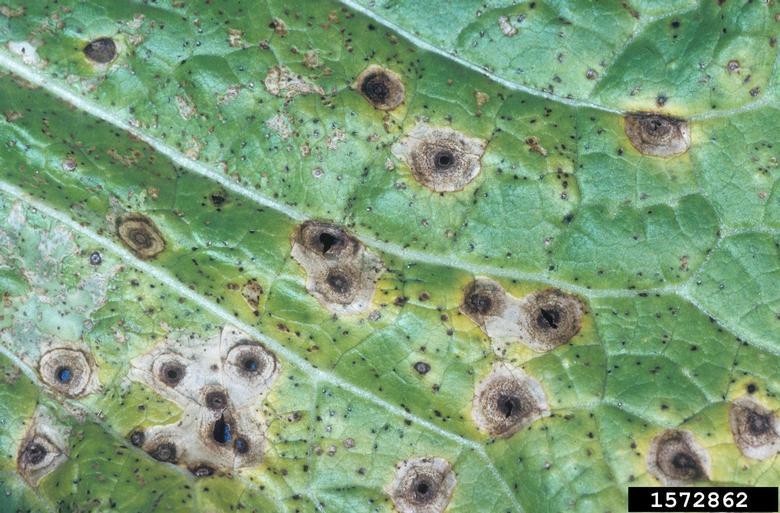
Symptoms on lower surface of Chinese cabbage leaf

Alternaria (Alternaria brassicicola) of cabbage.

Leaf spot on cabbage caused by Alternaria brassicicola

Chinese cabbage leaf showing many lesions caused by Alternaria brassicicola

Cabbage infected withblack spot (Alternaria brassicicola)

Black spot (Alternaria brassicicola) symptom

Close-up of Alternaria lesion on cabbage leaf

Chinese cabbage leaf showing many lesions caused by Alternaria brassicicola
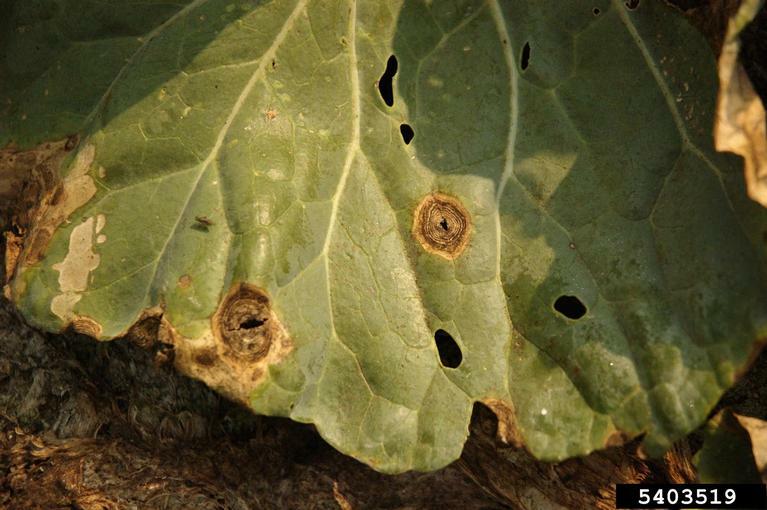
Concentric balck spots on leaf

Black spot infected cabbage leaf

Symptoms of Alternaria leaf spot on cabbage
Symptoms
Small dark spots on leaves which turn brown to gray; lesions may be round or angular and may possess a purple-black margin; lesions may form concentric rings, become brittle and crack in center; dark brown elongated lesions may develop on stems and petioles.
Cause
Fungus
Comments
Management
Plant only pathogen-free seed; rotate crops; applications of appropriate fungicides control disease when present.
Anthracnose
Colletotrichum higginsianum

anthracnose (Colletotrichum higginsianum) symptoms on turnip leaf

Anthracnose symptoms on cabbage leaf
Symptoms
Small circular or irregularly shaped dry spots which are gray to straw in color on leaves; a high number of spots may cause the leaf to die; lesions may coalesce to form large necrotic patches causing leaves to turn yellow and wilt; lesions may split or crack in dry centers.
Cause
Fungus
Comments
Management
Control of disease depends on sanitary practices; treat seeds with hot water prior to planting; rotate crops; plant in an area with good soil drainage; remove all cruciferous weeds which may act as a reservoir for the fungus.
Black rot
Xanthomonas campestris

Bacterial streaming from cut tissue

Symptoms on stem

A field with severe infection of black rot

Cabbage leaf with scorched appearance cuased by black rot infection
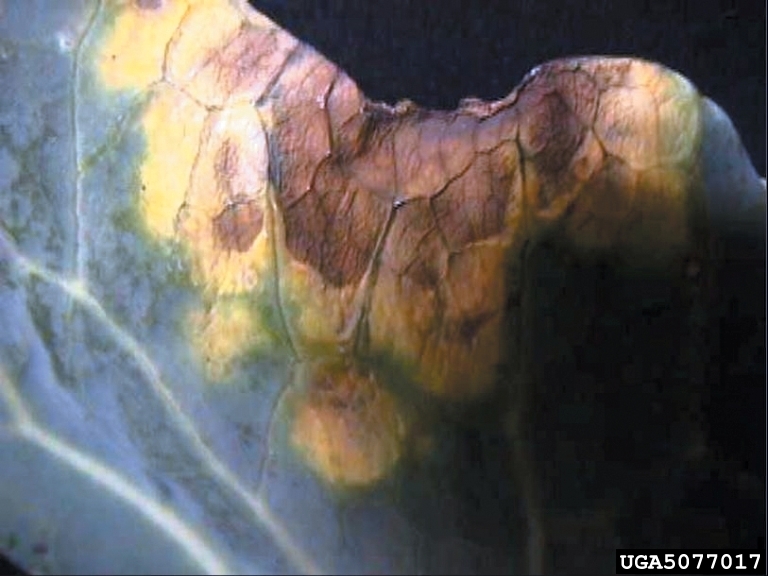
Initial infection begins as yellow "V" shaped spot on edge of leaf. Black veins eventually appear as infection spreads.

Extreme damage from black rot infection.

Black rot symptoms include large lesion on the margin of the leaves that causes sever leaf damage and yield losses on cabbage.

Savoy cabbage infected with black rot

Classic bright yellow lesions at the leaf margins

Typical V-shaped marginal chlorosis and necrosis caused by black rot.

The symptoms starts as V-shaped yellow lesions to the margin of the leaves. If the disease infection starts early i the season the entire plant can be severely affected. Blackened veins is another major symptom of black rot on cabbage.
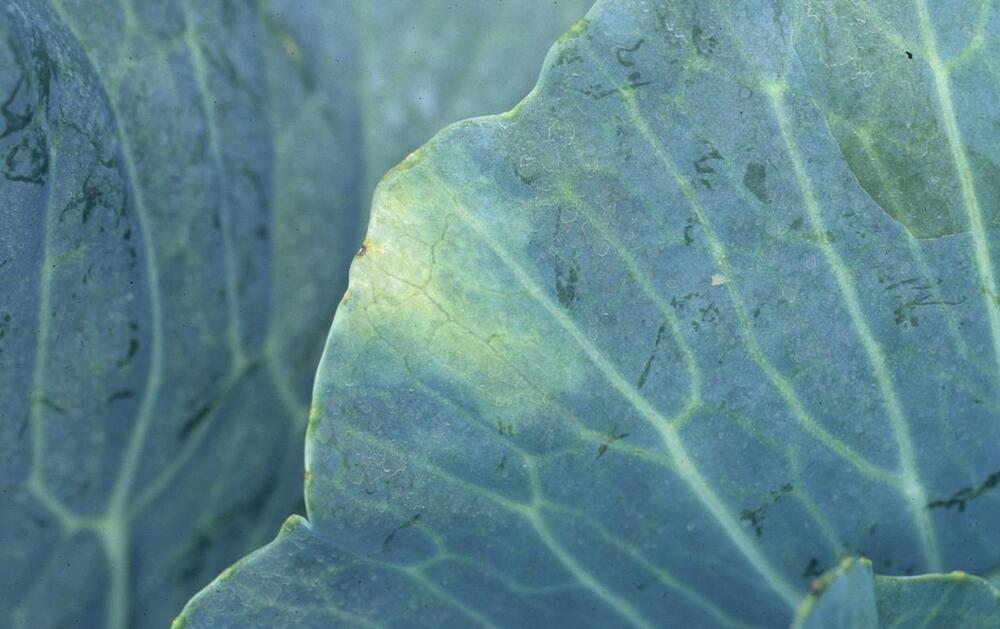
Early symptoms of black rot showing V-shaped lesion on cabbage leaf
Symptoms
Irregularly shaped dull yellow areas along leaf margins which expand to leaf midrib and create a characterstic "V-shaped" lesion; lesions may coalesce along the leaf margin to give plant a scorched appearance.
Cause
Bacterium
Comments
Management
Primary method of controlling black rot is through the use of good sanitation practices; rotate crops to non-cruciferous crops every 2 years; plant resistant varieties; control cruciferous weed species which may act as a reservoir for bacteria; plant pathogen-free seed.
Clubroot
Plasmodiophora brassicae

Cabbages in field showing symptoms of poor growth due to club root
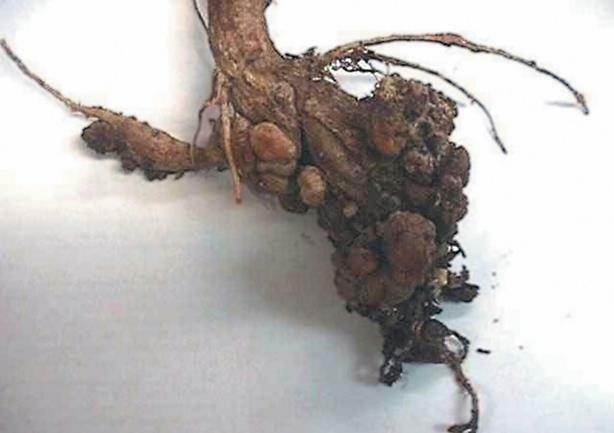
Distorted roots of cabbage plant caused by infection with club root fungus
Symptoms
Slow growing, stunted plants; yellowish leaves which wilt during day and rejuvenate in part at night; swollen, distorted roots; extensive gall formation
Cause
Fungus
Comments
Management
Once the pathogen is present in the soil it can survive for many years, elimination of the pathogen is economically unfeasible; rotating crops generally does not provide effective control; plant only certified seed and avoid field grown transplants unless produced in a fumigated bed; applying lime to the soil can reduce fungus sporulation
Damping-off (Wirestem, Head rot)
Rhizoctonia solani

Rotting lesion on cabbage leaf caused by infection with Rhizoctonia
Symptoms
Death of seedlings after germination; brown or black rot girdling stem; seedling may remain upright but stem is constricted and twisted (wirestem); in older cabbage plants sharply defined brown lesions appear on the underside of leaves; the lesions expand causing leaves to wilt and drop from plant
Cause
Fungus
Comments
Management
Plant pathogen-free seed or transplants that have been produced in sterilized soil; apply fungicide to seed to kill off any fungi; shallow plant seeds or delay planting until soil warms
Powdery mildew
Erysiphe cruciferarum
Symptoms
Small white patches on upper and lower leaf surfaces which may also show purple blotching; patches coalesce to form a dense powdery layer which coats the leaves; leaves become chlorotic and drop from plant
Cause
Fungus
Comments
Management
Plant resistant varieties; rotate crops; remove all crop debris after harvest; remove weeds; avoid excessive application of nitrogen fertilizer which encourages powdery mildew growth; powdery mildew can be controled by application of sulfur sprays, dusts or vapors
Sclerotinia stem rot (White mold)
Sclerotinia sclerotiorum
Symptoms
Irregular, necrotic gray lesions on leaves; white-gray leions on stems; reduced pod set; shattering seed pods
Cause
Fungus
Comments
Management
Rotate crop to non-hosts (e.g. cereals) for at least 3 years; control weeds; avoid dense growth by planting in adequately spaced rows; apply appropriate foliar fungicides
Watery soft rot (White rot, Cabbage drop)
Sclerotinia sclerotiorum

Cabbage infected with Sclerotinia

Cabbage head infected with Sclerotinia
Symptoms
Soft rotting area at base of stem which spreads upwards successively killing leaves by causing them to drop and infect the leaf below; when fungus reaches the head it causes a soft, slimy, watery rot
Cause
Fungus
Comments
Management
The number of sclerotia in the soil can be reduced by plowing crop debris deep into soil and rotating crops every 3 years with non-host crops; severe infestations may require control through application of appropriate fungicide
White rust
Albugo candida
Symptoms
White pustules on cotyledons, leaves, stems and/or flowers which coalesce to form large areas of infection; leaves may roll and thicken
Cause
Fungus
Comments
Management
Rotate crops; plant only disease-free seed; apply appropriate fungicide if disease becomes a problem
Category : Bacterial
Bacterial soft rot
Erwinia caratovora

Infected cabbage

Symptoms

Cabbage head with decay from soft-rotting, bacterial infection.

Bacterial soft rot on cabbage

Bacteria streaming from soft-rotted tissue under dark-field observation.

Bacterial soft rot on cabbage
Symptoms
Water-soaked lesions on cabbage head which expand to form a large rotted mass of cream colored tissue which is liquid underneath; surface of lesions usually crack and exude slimy liquid which turns tan, dark brown or black on exposure to air.
Cause
Bacterium
Comments
Management
Chemical treatments are not available for bacterial soft rot, control relies on cultural practices; rotate crops; plant cabbage in well-draining soils or raised beds; only harvest heads when they are dry; avoid damaging heads during harvest.
Blackleg
Leptosphaeria maculans
Symptoms
Damping-off of seedlings; round or irregularly shaped gray necrotic lesions on leaves with dark margins; lesions may be covered in pink masses in favorable weather conditions.
Cause
Fungus
Comments
Management
Cabbage does not have high levels of resistance to blackleg and fungicides use is uneconomical; use disease free seed or treat with hot water to remove fungus prior to planting; remove and destroy crop debris after harvest or plow deeply into soil.
Category : Fungal, Oomycete
Downy mildew
Peronospora parasitica

Downy mildew symptoms on cabbage leaf
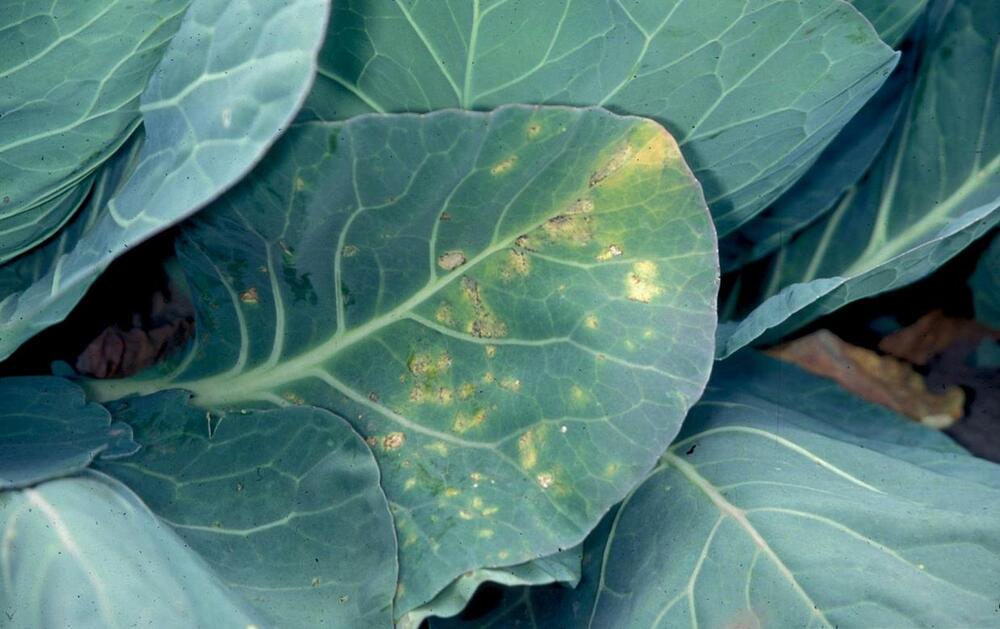
Downy mildew symptoms on cabbage leaf
Symptoms
Irregular yellow patches on leaves which turn light brown in color; fluffy gray growth on the undersides of the leaves
Cause
Fungus
Comments
Management
Remove all crop debris after harvest; rotate with non-brassicas; application of appropriate fungicides may be required if symptoms of disease are present
Category : Viral
Ring spot
Mycosphaerella brassicicola
Symptoms
Small, purple spots surrounded by a ring of water-soaked tissue on leaves which mature to brown spots with olive green borders 1-2 cm across; spots may develop numerous fruiting bodies which give them a black appearance or develop a concentric pattern; heavily infected leaves may dry up and curl inwards
Cause
Fungus
Comments
Management
Refrain from planting in areas known to have had disease previously; rotate crop to non-brassicas; sanitize tools and equipment regularly; apply appropriate fungicide if disease is identified in crop
Category : Other
Slugs & snails (Gray garden slug, Spotted garden slug, Brown garden snail, European garden snail , etc.)
Decoratus reticulatum
Limax maximus
Helix aspersa
Cornu aspersum
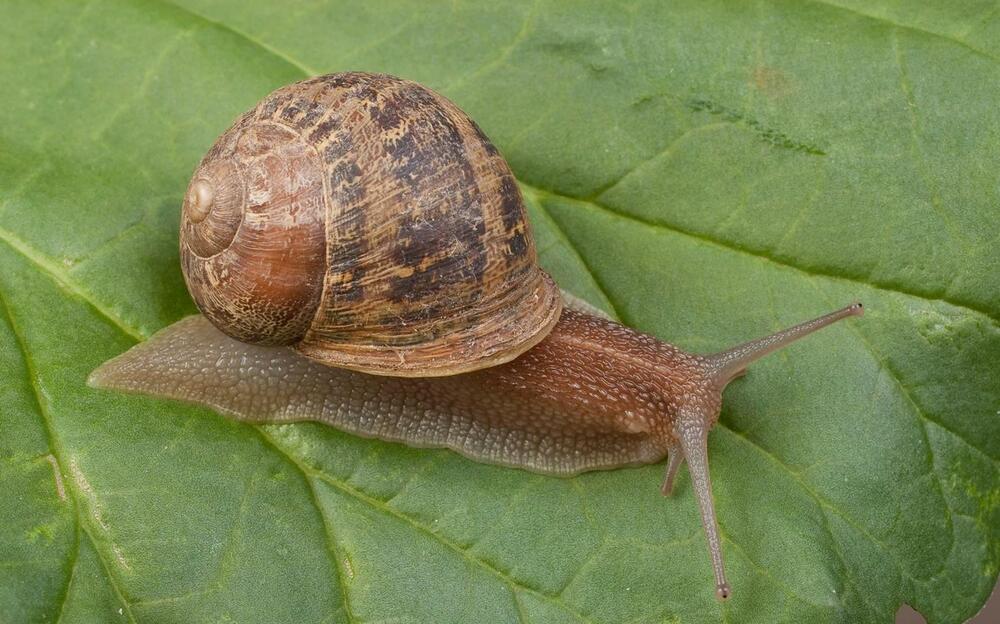
European brown snail

Gray garden slug
Symptoms
Irregularly shaped holes in leaves and stems; flowers and fruit may also be damaged if present; if infestation is severe, leaves may be shredded; slime trails present on rocks, walkways, soil and plant foliage; several slug and snail species are common garden pests; slugs are dark gray to black in color and can range in size from 2.5 to 10 cm (1-4 in); garden snails are generally smaller and possess a rounded or spiral shell
Cause
Mollusc
Comments
Management
Practice good garden sanitation by removing garden trash, weeds and plant debris to promote good air circulation and reduce moist habitat for slugs and snails; handpick slugs at night to decrease population; spread wood ashes or eggshells around plants; attract molluscs by leaving out organic matter such as lettuce or grapefruit skins, destroy any found feeding on lure; sink shallow dishes filled with beer into the soil to attract and drown the molluscs; chemical controls include ferrous phosphate for organic gardens and metaldehyde (e.g. Buggeta) and carbaryl (e.g Sevin bait) for non-organic growers
Pests
Category : Insects
Beet armyworm
Spodoptera exigua

beet armyworm (Spodoptera exigua) larvae on soybean leaf
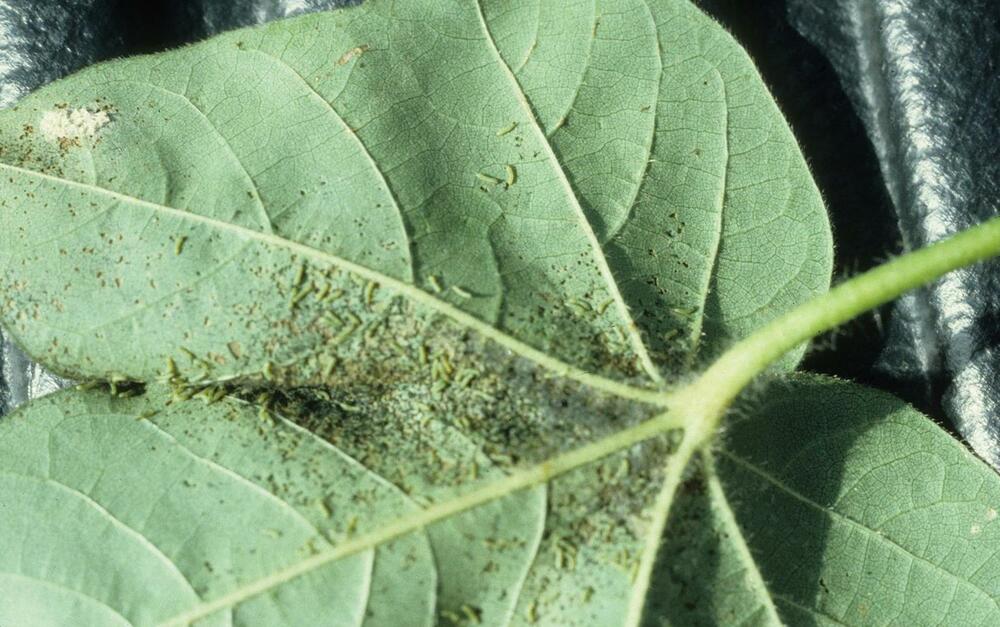
Young larvae

Beet armyworm adult

Beet armyworm eggs covered in white hairs

Larva of beet armyworm

Beet armyworm larva
Symptoms
Singular, or closely grouped circular to irregularly shaped holes in foliage; heavy feeding by young larvae leads to skeletonized leaves; shallow, dry wounds on fruit; egg clusters of 50-150 eggs may be present on the leaves; egg clusters are covered in a whitish scale which gives the cluster a cottony or fuzzy appearance; young larvae are pale green to yellow in color while older larvae are generally darker green with a dark and light line running along the side of their body and a pink or yellow underside.
Cause
Insect
Comments
Management
Organic methods of controlling the beet armyworm include biological control by natural enemies which parasitize the larvae and the application of Bacillus thuringiensis; there are chemicals available for commercial control but many that are available for the home garden do not provide adequate control of the larvae.
Cabbage aphid
Brevicoryne brassicaea
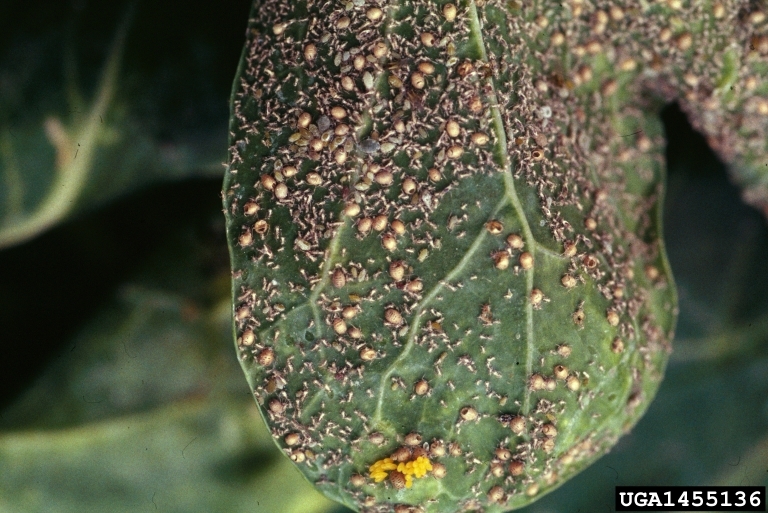
Lady beetles feeding on aphids

Dense colony

Adult aphid

Heavy infestation of cabbage leaves

Heavily infested leaf

Cabbage aphid adult
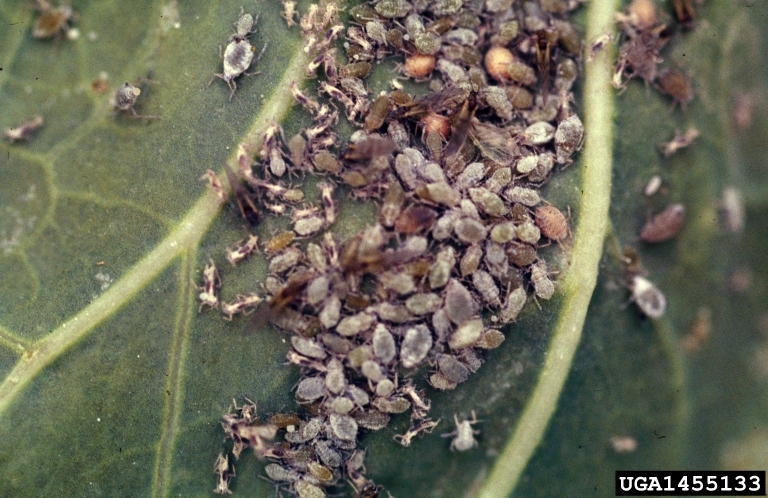
Aphid colony

Multiple life stage

Cabbage aphid colony on a cabbage leaf
Symptoms
Large populations can cause stunted growth or even plant death; insects may be visible on the plant leaves and are small, grey-green in color and soft bodied and are covered with a white waxy coating; prefer to feed deep down in cabbage head and may be obscured by the leaves.
Cause
Insect
Comments
Management
If aphid population is limited to just a few leaves or shoots then the infestation can be pruned out to provide control; check transplants for aphids before planting; use tolerant varieties if available; reflective mulches such as silver colored plastic can deter aphids from feeding on plants; sturdy plants can be sprayed with a strong jet of water to knock aphids from leaves; insecticides are generally only required to treat aphids if the infestation is very high - plants generally tolerate low and medium level infestation; insecticidal soaps or oils such as neem or canola oil are usually the best method of control; always check the labels of the products for specific usage guidelines prior to use.
Cabbage looper
Trichoplusia ni

Cabbage looper feeding on cabbage leaf
Symptoms
Large or small holes in leaves; damage often extensive; caterpillars are pale green with a white lines running down either side of their body; caterpillars are easily distinguished by the way they arch their body when moving; eggs are laid singly, usually on the lower leaf surface close to the leaf margin, and are white or pale green in color
Cause
Insect
Comments
Management
Management may be needed after cabbage heading; biological controls such as spraying with Bacillus thuringiensis can be effective at controlling looper numbers; application of appropriate insecticide after heading also controls looper populations; selective insecticides help to protect populations of natural enemies on crop
Cutworms
Agrotis spp.
Peridroma saucia
Nephelodes minians
and others
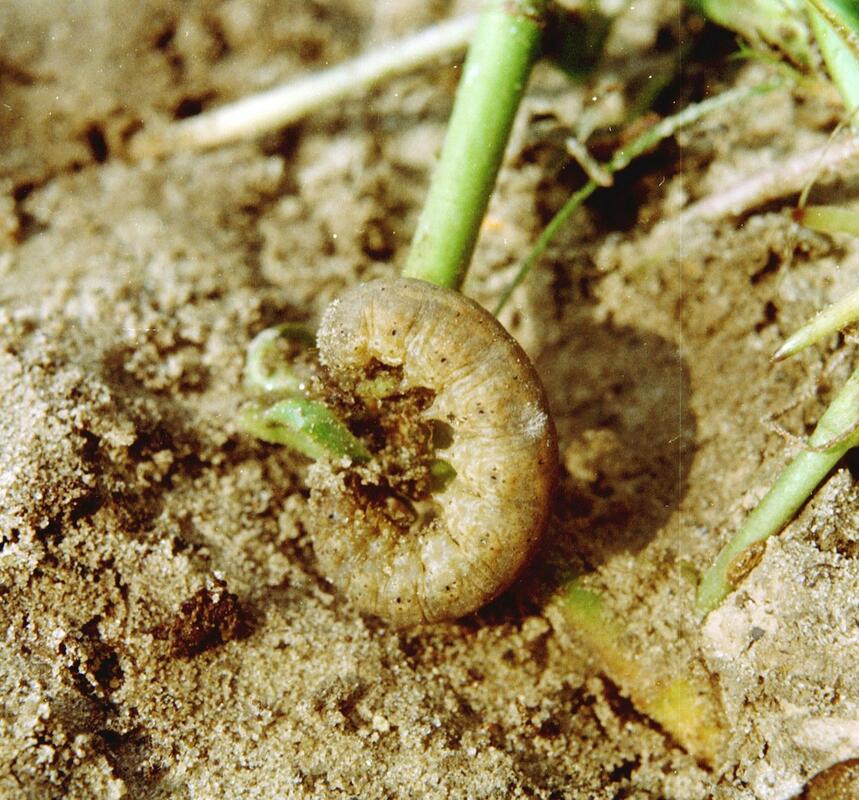
Cutworm feeding on plant stem

Cutworms will curl up into a characteristic C shape when disturbed

Cutworm larva severing plant stem
Symptoms
Stems of young transplants or seedlings may be severed at soil line; if infection occurs later, irregular holes are eaten into the surface of fruits; larvae causing the damage are usually active at night and hide during the day in the soil at the base of the plants or in plant debris of toppled plant; larvae are 2.5–5.0 cm (1–2 in) in length; larvae may exhibit a variety of patterns and coloration but will usually curl up into a C-shape when disturbed
Cause
Insect
Comments
Management
Remove all plant residue from soil after harvest or at least two weeks before planting, this is especially important if the previous crop was another host such as alfalfa, beans or a leguminous cover crop; plastic or foil collars fitted around plant stems to cover the bottom 3 inches above the soil line and extending a couple of inches into the soil can prevent larvae severing plants; hand-pick larvae after dark; spread diatomaceous earth around the base of the plants (this creates a sharp barrier that will cut the insects if they try and crawl over it); apply appropriate insecticides to infested areas of garden or field if not growing organically
Diamondback moth
Plutella xylostella
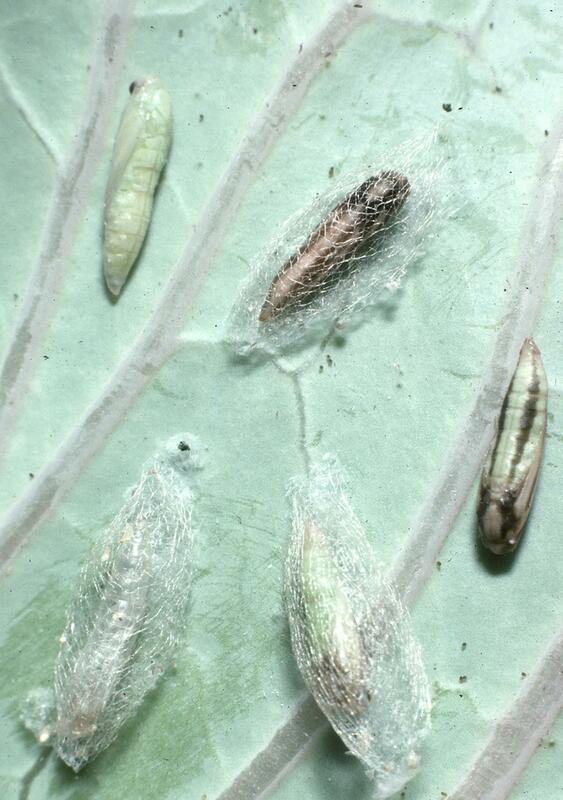
Diamondback moth pupae

Cabbage damaged by Diamondback moth larvae
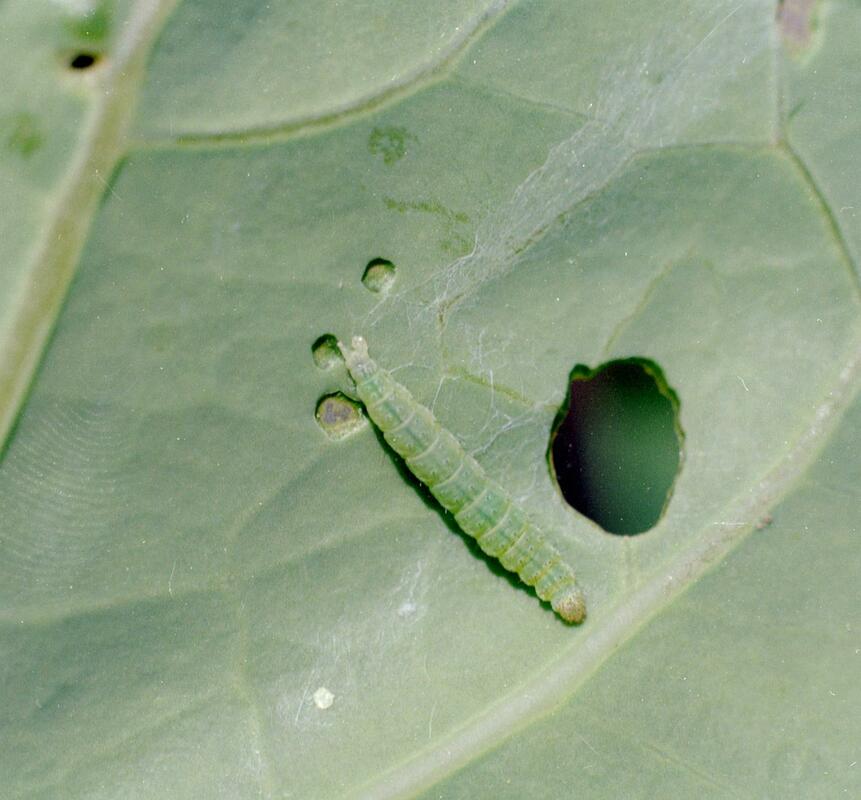
Larva feeding on cabbage leaf
Symptoms
Young larvae feed between upper and lower leaf surface and may be visible when they emerge from small holes on the underside of the leaf; older larvae leave large, irregularly shaped shotholes on leaf undersides, leaving the upper surface intact; larvae may drop from the plant on silk threads if the leaf is disturbed; larvae are small (1 cm/0.3 in) and tapered at both ends; larvae have to prolegs at the rear end that are arranged in a distinctive V-shape
Cause
Insect
Comments
Management
Larvae can be controlled organically by applications of Bacillus thurengiensis or Entrust; application of appropriate chemical insecticide is only necessary if larvae are damaging the growing tips of the plants
Flea beetle
Phyllotreta spp.

Crucifer flea beetles and damage on cabbage leaf
Symptoms
Small holes or pits in leaves that give the foliage a characteristic “shothole” appearance; young plants and seedlings are particularly susceptible; plant growth may be reduced; if damage is severe the plant may be killed; the pest responsible for the damage is a small (1.5–3.0 mm) dark colored beetle which jumps when disturbed; the beetles are often shiny in appearance
Cause
Insect
Comments
Management
In areas where flea beetles are a problem, floating row covers may have to be used prior to the emergence of the beetles to provide a physical barrier to protect young plants; plant seeds early to allow establishment before the beetles become a problem - mature plants are less susceptible to damage; trap crops may provide a measure of control - cruciferous plants are best; application of a thick layer of mulch may help prevent beetles reaching surface; application on diamotecoeus earth or oils such as neem oil are effective control methods for organic growers; application of insecticides containing carbaryl, spinosad, bifenthrin and permethrin can provide adequate control of beetles for up to a week but will need reapplied
Large cabbage white (Cabbageworm)
Pieres rapae

Cabbage damaged by cabbageworm

Cabbageworm and frass on a cabbage leaf
Symptoms
Large ragged holes in leaves or bored into head; green-brown frass (insect feces) on leaves; caterpillar is green in color and hairy, with a velvet-like appearance; may have faint yellow to orange stripes down back; slow-moving compared with other caterpillars
Cause
Insect
Comments
Management
Plant can tolerate quite a lot of damage from caterpillars between transplanting and heading; hand pick caterpillars from plants and destroy; scrape eggs from leaves prior to hatching; apply appropriate insecticide if infestation is very heavy
Thrips (Western flower thrips, Onion thrips, etc)
Frankliniella occidentalis
Thrips tabaci

Thrips damage to cabbage head

Onion thrips on cabbage
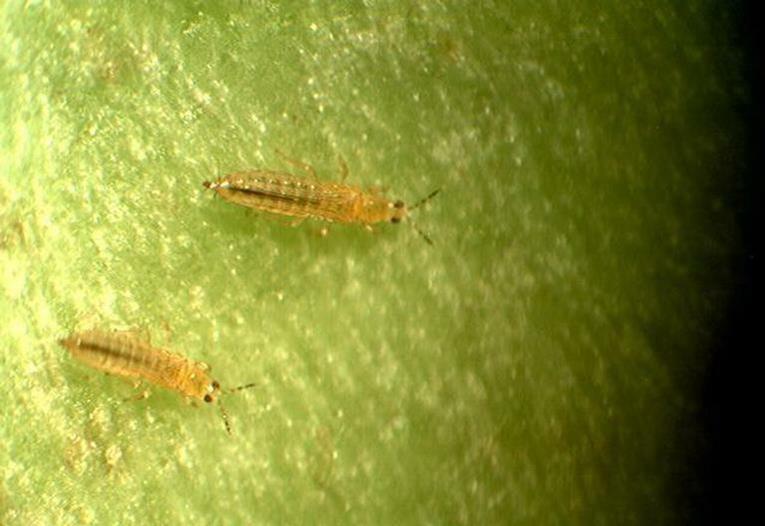
Western flower thrips
Symptoms
If population is high leaves may be distorted; leaves are covered in coarse stippling and may appear silvery; leaves speckled with black feces; insect is small (1.5 mm) and slender and best viewed using a hand lens; adult thrips are pale yellow to light brown and the nymphs are smaller and lighter in color
Cause
Insect
Comments
Management
Avoid planting next to onions, garlic or cereals where very large numbers of thrips can build up; use reflective mulches early in growing season to deter thrips; apply appropriate insecticide if thrips become problematic
Category : Nematodes
Root knot nematode
Meloidogyne spp.
Symptoms
Galls on roots which can be up to 3.3 cm (1 in) in diameter but are usually smaller; reduction in plant vigor; yellowing plants which wilt in hot weather
Cause
Nematode
Comments
Management
Plant resistant varieties if nematodes are known to be present in the soil ;check roots of plants mid-season or sooner if symptoms indicate nematodes; solarizing soil can reduce nematode populations in the soil and levels of inoculum of many other pathogens















































































